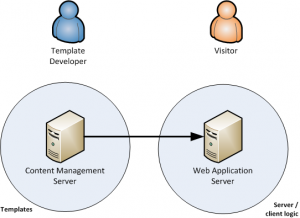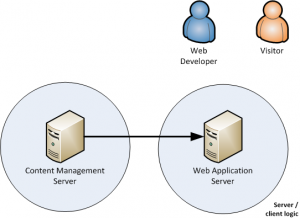The next DD4T release (1.30) which will be out shortly, features a new .NET library: DD4T.Web. This library contains functionality which can be used within a .NET web application, regardless of whether you are using MVC or not. In a short series I will introduce the most important functionality in this library. This episode: Publication Resolving.
DD4T is all about URLs. When the request comes in, the framework looks in the Tridion broker database for pages with a matching URL. Or rather: a matching path. For example: if the URL is http://www.acme.com/products/foobar.html, the path is /products/foobar.html.
But what if there are more matches? This is entirely possible because of Tridion’s BluePrinting model. Imagine the Acme corporation decides to launch a German web site, with the base URL http://www.acme.de. They manage this site in a Tridion publication which is a child of their ‘dotcom publication’ (which manages the www.acme.com site). Given the nature of BluePrinting, the German page about their ‘Foobar’ product, will have the url http://www.acme.de/products/foobar.html, and the path of this page is /products/foobar.html.
As you see, the path is identical to the path in the English publication. So how can DD4T tell which page to serve? This is done by the PublicationResolver. This is a very simple class, whose job it is to find out which publication the current request belongs to. In the example above, the PublicationResolver could look at the host name and return the correct publication id: if the host name is ‘www.acme.de’, it should return the id of the German publication, if it’s ‘www.acme.com’ it returns the id of the DotCom publication.
Resolving the publication based on the host name is an obvious choice in many cases, but there are alternative scenarios. For example: you could look at the preferred browser language and base the publication id on that. So: if my browser language is German, I will see the German site, regardless of the host name. Technically, I wouldn’t need the www.acme.de domain at all (although I don’t think Google will like it if the same URL can return a page in different languages!)
And then there is the simplest form of all: you can simply decide that all the requests in your web application should use the same publication id. This is actually the default behavior. DD4T comes with one implementation of the PublicationResolver interface, the DefaultPublicationResolver, and it simply looks in the Web.config for an appSetting called ‘DD4T.PublicationId’. This id is then used to look up all the pages, components and binaries. The downside is of course that you need to set up a separate web application for each language that you’re supporting. Not very efficient and tough to manage!
Implement your own resolver
It’s very easy to write your own publication resolver.
- First, create a class library project in Visual Studio.
- Add a class which implements the DD4T.ContentModel.Contracts.Resolvers.IPublicationResolver.
- Right-click the word IPublicationResolver and select ‘implement interface’.
Your code now looks like this:
using System;
using System.Web;
using DD4T.ContentModel.Contracts.Resolvers;
namespace Trivident.DD4T.Examples.PublicationResolvers
{
public class HostNamePublicationResolver : IPublicationResolver
{
public int ResolvePublicationId()
{
}
}
}
As you see, this interface defines only one method: ResolvePublicationId(). In that method, we will check the host name in the URL and use it to determine the publication id. In a very simple (not to say a moronic) form, the code might look like this:
using System;
using System.Web;
using DD4T.ContentModel.Contracts.Resolvers;
namespace Trivident.DD4T.Examples.PublicationResolvers
{
public class HostNamePublicationResolver : IPublicationResolver
{
public int ResolvePublicationId()
{
switch (HttpContext.Current.Request.Url.Host)
{
case "www.acme.de":
return 17;
case "www.acme.com":
return 16;
}
throw new InvalidOperationException(string.Format("unknown hostname '{0}", HttpContext.Current.Request.Url.Host));
}
}
}
In a real life implementation you would probably want to get rid of the hardcoded IDs, but the point is clear, I hope.
Using it in your application
The PublicationResolver is a property of the factories (PageFactory, ComponentFactory, BinaryFactory, LinkFactory). If you’re using a dependency injection framework (like MEF or Unity) you can simply configure it as a dependency of those factories. Otherwise, you can set it manually (in code). In your PageController for example:
private IPageFactory _pageFactory = null;
public override ContentModel.Factories.IPageFactory PageFactory
{
get
{
if (_pageFactory == null)
{
_pageFactory = base.PageFactory;
_pageFactory.PublicationResolver = new HostNamePublicationResolver();
}
return _pageFactory;
}
}
Using DD4T without publication resolving
It’s possible to use DD4T without doing any publication resolving. In that case the publication is not used when looking up the page in the broker database. This works if all the paths in your system are unique. So in our Acme example, the URLs of the English and German ‘foobar’ pages should be:
- http://www.acme.com/products/foobar.html (English)
- http://www.acme.com/de/products/foobar.html (German)
In this case, DD4T can and will always find the correct page.
If ‘the business’ can live with this style of URL, then go for it. It saves you the trouble of resolving anything!
To use this approach, just use the default publication resolver (this requires no action) and remove the key ‘DD4T.PublicationId’ from the Web.config.




